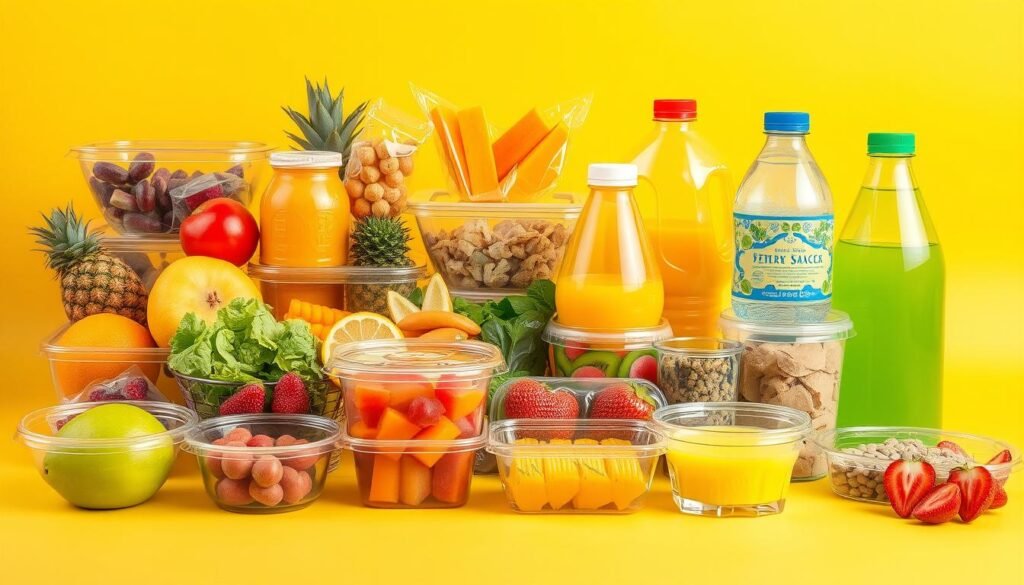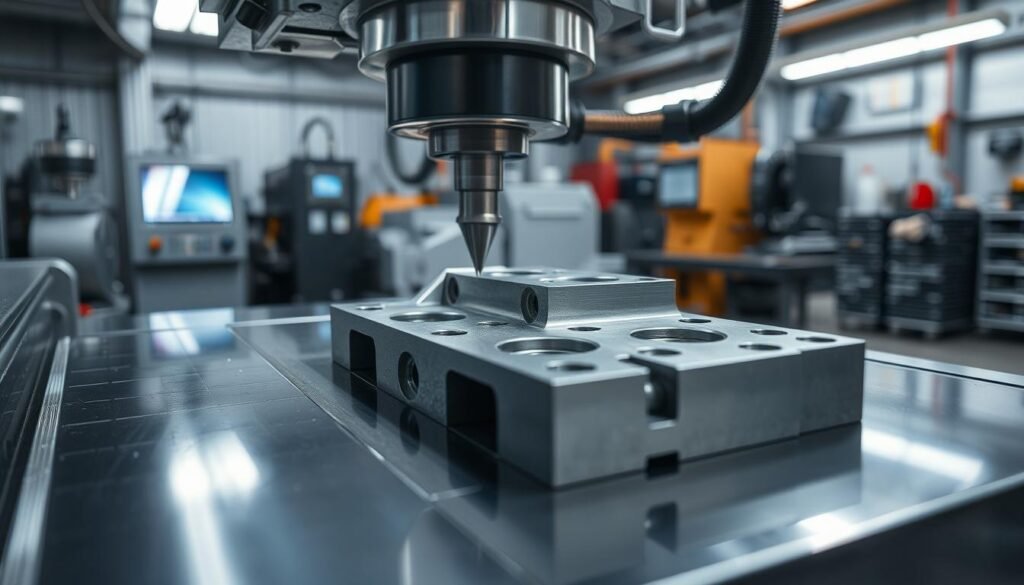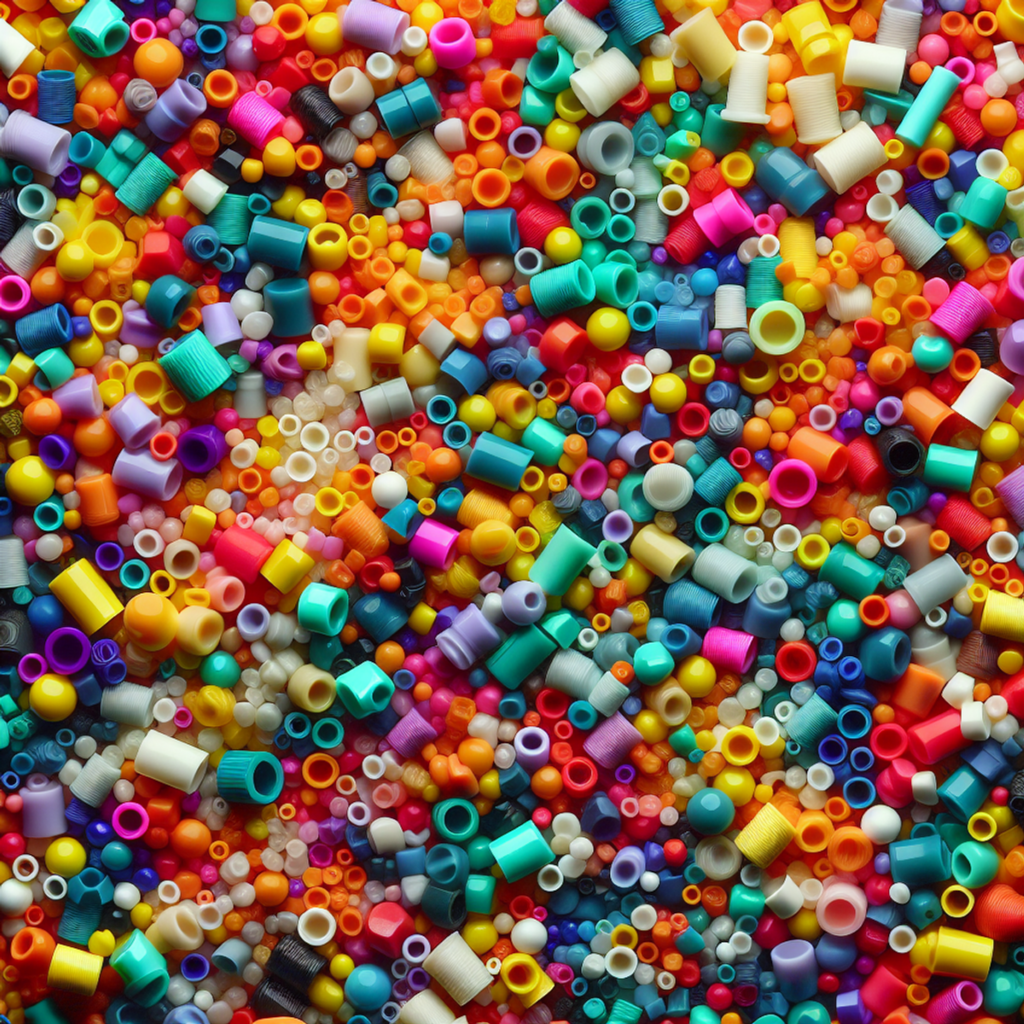More than half of the world’s synthetic fiber is PET, also known as polyester. Polyethylene terephthalate (PET) is clear and strong. It’s becoming the top choice for packaging, especially for food and drinks.
In the United States, over 1.5 billion pounds of used PET bottles and containers are recycled every year. This shows how valuable and popular PET plastic is.
Key Takeaways
- PET is the most recycled plastic in the United States, with a recycling rate of 31%.
- PET has a favorable sustainability profile, with 40% of its energy use attributed to “resource energy” that can be recaptured through recycling.
- PET is lightweight and shatterproof, making it an energy-efficient packaging material.
- PET is approved as safe for food and beverage contact by regulatory agencies.
- PET production accounts for a third of global plastic demand, with synthetic fibers being the majority of PET production.
What is PET Plastic?
PET stands for Polyethylene Terephthalate. It’s a clear, strong, and light plastic. It’s used a lot for food and drink packaging.
This material is special because of its chemical makeup. It also has a interesting history of how it was developed.
Definition and Chemical Composition
PET plastic is made from ethylene glycol and terephthalic acid. These are mixed to form a strong and clear plastic. It can handle heat, chemicals, and impacts well.
History and Development of PET
In the mid-1940s, DuPont chemists in North America made PET. They were looking for new fibers. Later, it was called “Dacron” and used for bottles and films since the 1970s.
PET’s ability to be versatile and strong made it popular in many fields.
| Key Facts about PET Plastic | Data |
|---|---|
| PET is the leading type of plastic used for beverage bottles | – |
| PET bottles are 100% recyclable and highly sustainable | – |
| PET bottles can be made with recycled content, such as 30% recycled PET | – |
| Recycled PET products offer an 81% reduction in carbon emissions compared to glass bottles | – |
| Virgin plastic can be eliminated from the production process, reducing up to 75% in carbon emissions | – |
Benefits of PET Plastic Bottles
PET plastic bottles are great for food and drink packaging. They save energy and are good for the planet. These bottles are light and won’t break easily, making them a smart choice for today’s shoppers.
Energy Savings and Sustainability
PET bottles need less energy and resources to make than glass. This means they have a smaller carbon footprint. They are also light, which helps save fuel and cuts down on emissions.
Lightweight and Shatterproof
PET bottles are very light, making them easy to carry and ship. This helps the environment by using less fuel. Plus, they won’t break easily, keeping things safe during transport.
| Benefit | Advantage |
|---|---|
| Energy Savings | PET plastic bottles use significantly less energy during manufacturing compared to glass containers. |
| Sustainability | The lightweight nature of PET bottles contributes to a smaller carbon footprint and more eco-friendly transportation. |
| Lightweight | PET plastic bottles are much lighter than glass, making them easier to handle and transport. |
| Shatterproof | PET bottles are highly resistant to shattering, ensuring the safety and integrity of the packaged products. |
In summary, PET plastic bottles offer many benefits. They save energy, are good for the planet, and are safe. This makes them a top choice for packaging food and drinks.
PET Plastic for Food and Beverage Packaging
PET, or polyethylene terephthalate, is a common plastic used in food and drink packaging. It’s safe, lasts long, and can be recycled. This makes it great for many items, like water bottles and food containers.
Safety and Regulatory Approvals
PET plastic has been checked and okayed by many global health groups. The FDA in the U.S. says it’s safe for food and drinks. It doesn’t have BPA or phthalates, which are bad for health. So, PET is a good pick for food and drink packaging.
PET is also the most recycled plastic globally. In Norway, 97% of PET bottles are recycled, used up to 12 times. This shows PET’s role in being green and safe.
“PET packaging is used in various industries, including food and beverage, wine and spirits, pharmaceuticals, cosmetics, electronics, household items, toys, and in-store marketing displays.”
PET plastic is a top choice for packaging. It’s safe and works well, giving people confidence in what they buy.

PET Plastic: Uses and Benefits
PET (Polyethylene Terephthalate) plastic is key in many industries. It’s versatile and affordable for many uses. It’s used in food and drink packaging, car parts, and clothes.
PET plastic is great because it doesn’t react with chemicals. This makes it perfect for food and beauty products. It can handle cold and acidic conditions well.
In the textile world, PET is turned into polyester fibers. This shows a big push for being green. It’s also used in cars because it’s light and strong.
| Industry | PET Plastic Benefits |
|---|---|
| Food and Beverage | Lower production costs, reduced water and energy consumption |
| Cosmetics and Healthcare | Ability to withstand low temperatures and acidic environments |
| Textile | Recycling into polyester fibers for environmental sustainability |
| Automotive | Weight reduction and improved aerodynamics |
PET plastic is vital in many fields. Its wide use and benefits are why it’s so popular.
“PET plastic has become an essential material in a wide range of industries, offering a versatile and cost-effective solution for various applications.”
Advantages of Using PET Plastic Bottles
PET plastic bottles have many benefits. They are chemically resistant. This means they keep food and drinks fresh by blocking oxygen. It’s great for keeping things safe and fresh.
PET plastic is also very flexible. This lets companies make unique packaging. They can make bottles that look good and stand out. The clear and shiny look of PET plastic is also a big plus.
| Advantage | Explanation |
|---|---|
| Chemical Resistance | PET creates a strong barrier, allowing little to no oxygen to pass through, ensuring product freshness and safety. |
| Flexibility and Design Options | PET plastic can be shaped into various forms, allowing for distinctive and visually appealing packaging. |
“PET plastic is the single best packaging solution for reducing global warming in the US, producing significantly fewer greenhouse gas emissions and requiring less energy to produce than glass and aluminium.”
PET plastic is a top choice for packaging. Its benefits and versatility make it popular. It’s good for the environment and helps companies stand out.
Recycling and Environmental Impact
PET plastic is very recyclable, making it better for the environment. In the U.S., over 1.5 billion pounds of PET are recycled each year. This reduces harm to our planet because PET can be recycled and reused.
Recycled PET is used to make many things like bottles, jars, and even clothes. It’s safe in landfills because it doesn’t harm the environment. But, PET plastic takes a long time to break down, up to 500 years.
Recyclability of PET Plastic
PET plastic is very recyclable, with a 29.1% recycling rate in the U.S. as of 2018. It’s cleaned and melted down to make new PET resin. This resin is used to make many products, from bottles to clothes.
Landfill and Biodegradability
PET plastic is recyclable, but bottles in landfills take 500 years to break down. This is a big problem. PET plastic doesn’t easily decompose, staying in landfills and nature for a long time.
This shows we need to recycle more PET and find better ways to dispose of it. This will help reduce its harm to our planet.

“Recycling PET plastic is essential to reducing its environmental impact, but more work is needed to increase recycling rates and explore alternative disposal methods to address the long-term presence of PET in landfills and the natural environment.”
PET Plastic in Other Industries
Polyethylene terephthalate (PET) plastic is not just for bottles. It’s also used in cars and clothes. This shows how useful PET plastic is in our world today.
Automotive Industry
PET plastic is great for cars. It’s light and strong, making cars go farther on a tank of gas. It also makes cars quieter and more comfy to drive.
As cars get greener, PET plastic is playing a big part. It’s helping make cars lighter and more fuel-efficient.
Textile and Fashion Industry
PET plastic is also used in clothes and accessories. Old PET bottles are turned into polyester fibers. This makes clothes that are good for the planet.
Brands that use recycled PET show they care about the environment. They give customers clothes that are both stylish and eco-friendly.
| Industry | PET Plastic Utilization | Benefits |
|---|---|---|
| Automotive | Components and interior design | Lightweight, improved fuel efficiency and aerodynamics, enhanced acoustic insulation |
| Textile and Fashion | Recycled PET (rPET) converted into polyester fibers | Reduced waste, eco-friendly and sustainable fashion choices, high-quality and durable textiles |
PET plastic is becoming more popular in cars and clothes. It’s helping make our world more sustainable. Its use is set to grow even more.
Safety Concerns and Myths About PET Plastic
PET plastic is safe and reliable for packaging. It doesn’t have harmful chemicals like BPA or phthalates. It also doesn’t create harmful substances when heated.
The FDA has studied PET plastic for over 30 years. They say it’s safe for food and drinks. Many studies have shown it’s safe for consumer goods.
But, there are some safety worries about PET plastic:
- Antimony leaching: Antimony can leak out at high temperatures. This might raise cholesterol and lower blood sugar. It could also affect estrogen levels.
- Phthalate migration: Phthalates are not in PET bottles but can be added. They can leak out, especially with heat and UV. This could harm the endocrine system.
- Estrogenic activity: Some studies found PET water can act like estrogen. This can harm hormone systems.
To lessen these worries, experts suggest using glass. Avoid high heat and long storage. Support green chemistry and test for plastic chemical exposure.
“The safety of PET plastic has been extensively studied and validated by regulatory bodies such as the FDA. For over 30 years, PET has been approved as safe for direct food and beverage contact.”
PET plastic is still widely used and mostly safe. Knowing the facts and taking precautions helps us use PET plastic wisely.
Future Trends and Innovations in PET Plastic
PET plastic is set to remain key in many fields, thanks to new ideas and improvements. These changes aim to make PET lighter and more eco-friendly. They also focus on finding new uses and recycling methods to boost PET’s role in the circular economy.
The push to make PET more recyclable is growing. In 2021, 31 percent of green PET in the U.S. was turned into clean, recycled material. This shows we need better recycling systems to handle more PET waste.
New recycling methods, like chemical recycling, are showing promise. Eastman, for instance, has a facility that can process 250 million pounds of waste plastic each year. This technology breaks down PET into its basic parts for making new products.
Improvements in recycling colored and opaque PET are also underway. These types make up over half of the PET at Eastman’s Kingsport facility. The Recycling Partnership is helping to process over 6 million pounds of these PET types, with more plans ahead.
PET plastic is also being used in new ways, like in textiles and cars. Polyester fibers made from PET are strong, wrinkle-free, and keep moisture away. They’re great for clothes and other fabrics. Mixing PET with other fibers creates materials that are light, breathable, and easy to clean.
As people want more eco-friendly options, PET makers and leaders are investing in better recycling tech. They aim to make recycling PET more efficient and cut down on waste in landfills and oceans. These advancements in PET plastic are setting the stage for a greener, more circular economy.
PET Plastic Manufacturing Process
PET (Polyethylene Terephthalate) plastic is used in many fields, like packaging and textiles. The making of PET plastic involves several steps. It turns raw materials into the final product. Knowing how PET plastic is made helps us see its value and how it’s good for the planet.
The main materials for making PET are ethylene glycol from oil and purified terephthalic acid (PTA). PTA can also come from paraxylene. In the making process, these materials mix in a reactor at high heat to form PET resin pellets.
Bottle-blowing machines can make thousands of bottles every hour. This shows how fast and efficient PET bottle making is. Quality checks are strict to make sure the bottles are right in size, thickness, and look.
PET plastics are used in many areas, like textiles, cars, food containers, films, and more. But, making PET plastic uses a lot of energy. This is a big problem for the environment.
People are working hard to find better ways to make PET plastic. They want to use less energy and make the process better for the planet.
| Key Statistics | Value |
|---|---|
| World plastics production in 2016 | 335 million metric tons |
| Single-use plastic production | Around 50% of world plastics production |
| Single-use plastic bottles purchased per minute | 1 million |
| Single-use plastic bottles purchased annually in the U.S. | Over 50 billion |
| Disposable cups consumed annually | 500 billion |
| Styrofoam coffee cups discarded annually by Americans | 25 billion |
| Plastic packaging production annually | 78 million tons |
| Plastic packaging ending up in waterways | 32% |
| Projected plastic in oceans compared to fish by 2050 | More plastic than fish |
| Plastic waste not recycled since the inception of plastic materials | 91% |
| Recycled plastic bottles discarded before being down-cycled | Up to 70% |
These numbers show the big environmental problems caused by single-use PET plastic. We really need better ways to make and use PET plastic.
“Individuals are encouraged to avoid purchasing single-use plastic bottles and opt for reusable alternatives to mitigate the plastic pollution crisis.”
Conclusion
PET plastic is very popular in many fields, especially for food and drink packaging. It’s strong, doesn’t break easily, and can be recycled. It keeps getting better, helping us be more green.
But, we must think about PET plastic’s effects on our planet and health. Making PET plastic uses a lot of energy. Also, it has chemicals that might not be good for us. We need to find ways to make it safer and cleaner.
In the end, PET plastic conclusion is that it’s still useful but we must use it wisely. We can do this by using less plastic, picking natural materials, and recycling more. This way, we can make the world a better place for PET plastic and for us.
FAQ
What is PET (polyethylene terephthalate)?
PET is a clear, strong plastic. It’s also very recyclable. In the U.S., it’s the most recycled plastic.
How is PET plastic used?
Beverage companies use PET for bottles that can be recycled 100%. The FDA says it’s safe for drinks and food.
What are the benefits of PET plastic bottles?
PET bottles save energy and are good for the planet. They use less energy and resources than glass. They’re also light and won’t break easily, making them safe and cheap to ship.
Is PET plastic safe for food and beverage contact?
Yes, the FDA says PET is safe for food and drinks in the U.S. It’s been tested for over 30 years. It doesn’t have harmful chemicals like BPA or phthalates.
What are the other industries that use PET plastic?
PET is used in cars and clothes too. In cars, it makes parts lighter and improves sound. In clothes, recycled PET makes new fibers for sustainable fashion.
Is PET plastic recyclable?
Yes, PET can be recycled completely. In the U.S., over 1.5 billion pounds are recycled each year. It can be melted down to make new plastic.
What are the future trends and innovations in PET plastic?
PET will keep growing in importance with new ideas. Expect better light-weighting and recycling. These changes will help the planet more.
Source Links
- https://petresin.org/an-introduction-to-pet/
- https://www.theplasticbottlescompany.com/plastic-types/pet-plastic/?srsltid=AfmBOoqmDKhoNnBfnbGg90yqHcD2Ra_gzTxi5eaEzcQ3mV9BbaY3znfW
- https://www.tdipacksys.com/blog/pe-vs-pet/
- https://www.petainer.com/pet-plastic-bottles/how-is-pet-different-from-other-plastic-types
- https://www.theplasticbottlescompany.com/plastic-types/pet-plastic/?srsltid=AfmBOoomIEO5rBdtFWvqCbaScFbFDIy2G4RUV0Qv6LoqDFYy9aOpcKXY
- https://www.gilplastic.com/benefits-of-pet-plastic-bottles/
- https://www.alcion.com/en/pet-plastic-bottles-what-are-they-and-which-are-their-benefits/
- https://www.ncbi.nlm.nih.gov/pmc/articles/PMC9231234/
- https://www.ptpackaging.com/products-services/pet-packaging/
- https://sailorplastics.com/blog/packaging-your-food-and-beverages-with-pet-plastics/?srsltid=AfmBOordCUJfp-YEQzbl_WWYs5LFur9BKxt9KwRziy0TM0H45gzHUoA1
- https://www.repetco.com/main-uses-of-pet-the-king-of-plastic-materials/
- https://www.tricorbraun.com/blog/benefits-of-pet-plastic-bottle-packaging.html
- https://www.xometry.com/resources/materials/polyethylene-terephthalate/
- https://www.uppi.com/what-is-pet-plastic/
- https://www.packaging-gateway.com/news/pet-plastic-bottles-deemed-more-sustainable-than-aluminium-or-glass/
- https://nems.nih.gov/sustain/Pages/PETWaterBottleImpact.aspx
- https://foodprint.org/blog/impacts-of-a-plastic-bottle/
- https://ecologycenter.org/plastics/ptf/report3/
- https://www.3devo.com/blog/ultimate-guide-to-pet-plastic
- https://millionmarker.com/blogs/blog/single-use-plastic-and-your-health-can-pet-plastic-cause-harm
- https://www.bpf.co.uk/Sustainability/pet_plastic_bottles_facts_not_myths.aspx
- https://trellis.net/article/new-technologies-enable-colorful-future-circularity-pet-plastic/
- https://www.hydepackage.com/info-detail/a-brief-history-and-future-of-pet-plastic
- https://drinkpathwater.com/blogs/news/what-exactly-is-pet-plastic?srsltid=AfmBOooiwyd-HmmFRWmizx3Im5pJ0PUS3ci7Kzopz2AnydYXLS-63IMJ
- https://wkaiglobal.com/blogs/what-is-the-process-for-the-manufacture-of-pet-plastic
- https://madesafe.org/blogs/viewpoint/chemical-profile-polyethylene-terephthalate-pete
- https://kbdelta.com/blog/polyethylene-terephthalate-pet-durable-plastic/






